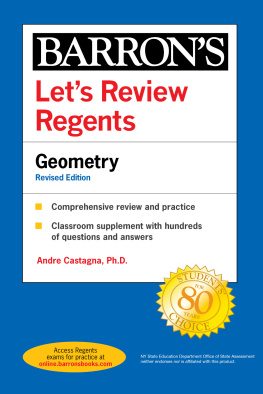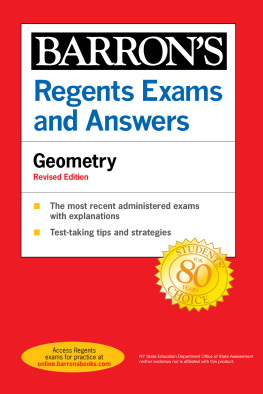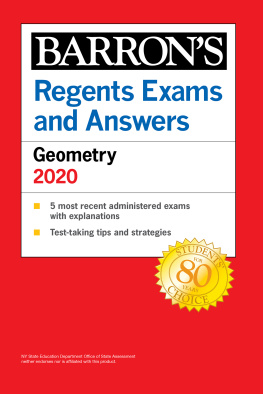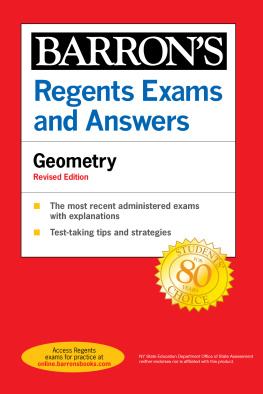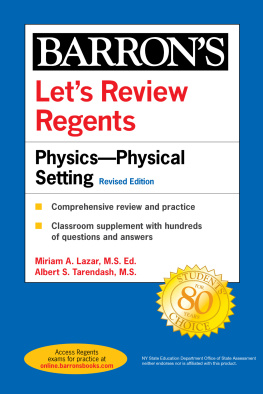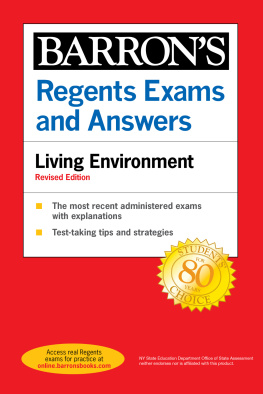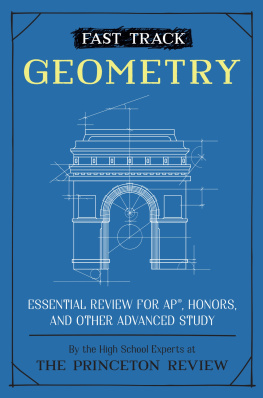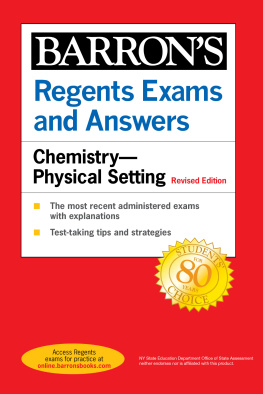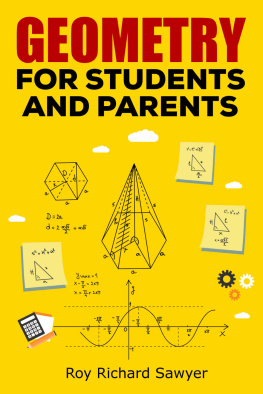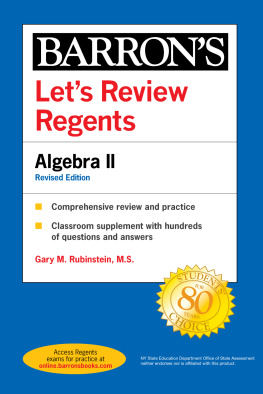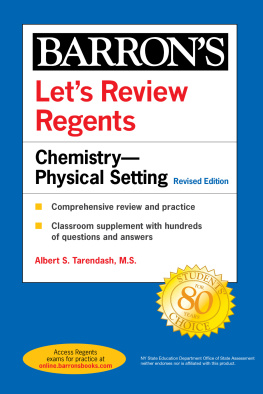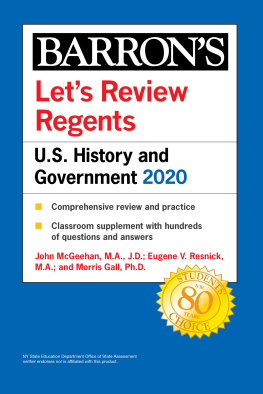Copyright 2021, 2020, 2018, 2017, 2016 by Kaplan, Inc., d/b/a Barrons Educational Series
All rights reserved under International and Pan-American Copyright Conventions. By payment of the required fees, you have been granted the non-exclusive, non-transferable right to access and read the text of this eBook on screen. No part of this text may be reproduced, transmitted, downloaded, decompiled, reverse engineered, or stored in or introduced into any information storage and retrieval system, in any form or by any means, whether electronic or mechanical, now known or hereinafter invented, without the express written permission of the publisher.
Published by Kaplan, Inc., d/b/a Barrons Educational Series
750 Third Avenue
New York, NY 10017
www.barronseduc.com
ISBN: 978-1-5062-7207-8
10 9 8 7 6 5 4 3 2 1
Dedication
To my loving wife, Loretta, who helped make this endeavor possible with her unwavering support; my geometry buddy Eva; and my future geometry buddies Rose and Henry.
Preface
This book presents the concepts, applications, and skills necessary for students to master the Geometry Common Core curriculum. Topics are grouped and presented in an easy-to-understand manner similar to what might be encountered in the classroom. Both students preparing for the Regents exam and teachers planning daily classroom lessons will find this book a valuable resource.
Special Features of This Book
- Aligned with the Common Core
This book has been rewritten to reflect the curriculum changes found in the Common Coreboth in content and in degree of critical thinking expected. The Geometry Common Core curriculum has placed more emphasis on transformational geometry, especially as applied to congruence. This emphasis has been integrated throughout the book in each chapter. Example problems and practice exercises can be found throughout this book. These demonstrate higher-level thinking, applying multiple concepts in a single problem, making connections between concepts, and demonstrating understanding in words. - Easy-to-Read Format
Topics are arranged in a logical manner so that examples and practice problems build on material from previous chapters. This format complements the presentation of material a student may see in the classroom. The format makes this book an excellent resource both for improving understanding throughout the school year and for preparing for the Regents exam. Numerous example problems with step-by-step solutions are provided, along with many detailed figures and diagrams to illustrate and clarify the topic at hand. Each subsection begins with a Key Ideas summary of the major facts the student should take away from that section. Math Facts can be found throughout the book and provide further insight or interesting historical notes. - Review of Algebra Skills
The first chapter of this book contains a review of practice problems of the algebra skills required to work through some of the problems encountered in geometry. Although many geometry problems involve pure reasoning, logic, and application of geometric principles, students can expect to encounter numerical problems in which they must apply equation-solving skills learned in previous years. - An Introduction to Proofs
A step-by-step guide to writing accurate geometry proofs can be found in chapter 4. Students are provided with the opportunity to develop the skills needed to write proofs by starting with just a small handful of geometric concepts and tools. The scaffolding provided in this chapter will help students develop the skills and confidence needed to meet the demands of the Common Core curriculum successfully. Both the two-column and paragraph formats of proofs are presented. - A Wide Variety of Practice Problems and Two Actual Regents Exams
The practice problems at the end of each subsection feature a range of complexity. Basic application of skills, including applying a formula or recalling a definition, lead into multistep problem solving and critical analysis. Problems that ask students to put their understanding in writing can also be found in each chapter. These practice problems include a large number of multiple-choice questions, similar to what can be expected on the Regents exam. The answers to all Check Your Understanding problems are provided. Two actual Regents exams with answer keys are included. These give students valuable experience with the style, format, and length of the Geometry Common Core Regents exam. - A Detailed Description of the Exam Format and Study Tips
The format of the exam, point distribution among topics, and scoring conversion are thoroughly explained. Students can use this information to help focus their efforts and ensure that they thoroughly master topics with high point value. Study tips and advice for test day are provided to help students make the most of their study time. - The Common Core Standards
A complete list of the Geometry Common Core standards can be found in Appendix I. All teachers should be thoroughly familiar with the content of these standards.
Whats Not in This Book
This review book does not provide proofs for all the theorems found within it. In fact, it shows fewer proofs than the typical geometry textbook. The theorems and proofs that were included in this work are those that:
- illustrate the level of complexity expected of students
- demonstrate specific strategies and approaches that a student may be expected to apply
- are specifically required within the Common Core geometry learning standards
Students are strongly encouraged to read and understand the proofs that are included here carefully. They should be able to complete on their own any proof noted to be specifically required by the Core Curriculum. Of course, rote memorization of these proofs is strongly discouraged. Instead, students should familiarize themselves with the tools and strategies used in proofs and then be able to work through the proofs by applying their critical thinking and geometry skills.
Who Will Benefit from Using This Book
- Students who want to achieve their best-possible grade in the classroom and on the Regents exam will benefit. Students may use this book as a study guide for both their day-to-day lessons and for the Regents exam.
- Teachers who would like an additional resource when planning geometry lessons aligned to the Common Core will benefit.
- Curriculum and district administrators who want to ensure their math departments curriculum is aligned to the Common Core will benefit.
Chapter
One
The Tools of Geometry
1.1 The Building Blocks of Geometry
Key Ideas
The building blocks of geometry are the point, line, and plane. The definitions of the other geometric figures can all be traced back to these three. We can think of the point, line, and plane as analogous to the elements in chemistry. All compounds are built up from the elements in the same way that the geometric figures are built up of points, lines, and planes. Along with definitions, we also look at the notation used for each. The ability to interpret vocabulary and notation is important for success in geometry.
Point, Lines, and Planes
A point is location in space. It is zero dimensional, having no length, width, or thickness. Points are represented by a dot and named with a capital letter, as shown by Point A in Figure 1.1a. Dont let the dot confuse you points are infinitely small. Even the smallest dot you can draw is two-dimensional.

